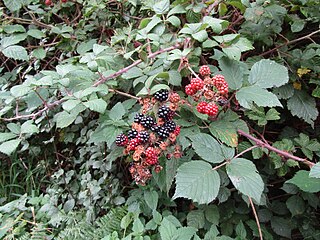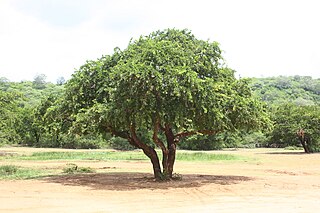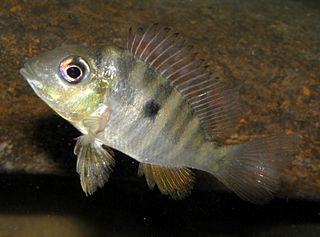
Thyme is a culinary herb consisting of the dried aerial parts of some members of the genus Thymus of flowering plants in the mint family Lamiaceae. Thymes are native to Eurasia and north Africa. Thymes have culinary, medicinal, and ornamental uses. The species most commonly cultivated and used for culinary purposes is Thymus vulgaris, native to Southeast Europe.

Genus is a taxonomic rank above species and below family as used in the biological classification of living and fossil organisms as well as viruses. In binomial nomenclature, the genus name forms the first part of the binomial species name for each species within the genus.

Rubus is a large and diverse genus of flowering plants in the rose family, Rosaceae, subfamily Rosoideae, with over 1,350 species, commonly known as brambles.

Geranium is a genus of 422 species of annual, biennial, and perennial plants that are commonly known as geraniums or cranesbills. They are found throughout the temperate regions of the world and the mountains of the tropics, with the greatest diversity in the eastern part of the Mediterranean region.

Penstemon, the beardtongues, is a large genus of roughly 280 species of flowering plants native to North America from northern Canada to Central America. It is the largest genus of flowering plants endemic to North America. As well as being the scientific name, penstemon is also widely used as a common name for all Penstemon species alongside beardtongues.

Hyacinthus is a small genus of bulbous herbs, spring-blooming perennials. They are fragrant flowering plants in the family Asparagaceae, subfamily Scilloideae and are commonly called hyacinths. The genus is native predominantly to the Eastern Mediterranean region from the south of Turkey to the Palestine region, although naturalized more widely.

Begoniaceae is a family of flowering plants with two genera and about 2040 species occurring in the subtropics and tropics of both the New World and Old World. All but one of the species are in the genus Begonia. There have been many recent discoveries of species in the genus Begonia, such as Begonia truncatifolia which is endemic to San Vincente, Palawan. B. truncatifolia is smaller than other species of the genus Begonia and this new species is proposed Critically Endangered by standards set by the IUCN. The only other genus in the family, Hillebrandia, is endemic to the Hawaiian Islands and has a single species. Phylogenetic work supports Hillebrandia as the sister taxon to the rest of the family. The genus Symbegonia was reduced to a section of Begonia in 2003, as molecular phylogenies had shown it to be derived from within that genus. Members of the genus Begonia are well-known and popular houseplants.
Ferganocephale is a dubious genus of neornithischian dinosaur. It was from the Middle Jurassic Balabansai Svita of Kyrgyzstan. The type and only species is F. adenticulatum.

The 5000 metres or 5000-metre run is a common long-distance running event in track and field, approximately equivalent to 3 miles 188 yards or 16,404 feet 2 inches. It is one of the track events in the Olympic Games and the World Championships in Athletics, run over 12+1⁄2 laps of a standard track. The same distance in road running is called a 5K run; referring to the distance in metres rather than kilometres serves to disambiguate the two events. The 5000 m has been present on the Olympic programme since 1912 for men and since 1996 for women. Prior to 1996, women had competed in an Olympic 3000 metres race since 1984. The 5000 m has been held at each of the World Championships in Athletics in men's competition and since 1995 in women's.

Limonia acidissima is the only species within the monotypic genus Limonia. Common names for the species in English include wood-apple and elephant-apple. It is sometimes also called monkey fruit.

Enneapterygius is a genus of fish in the family Tripterygiidae found in the Indian and Pacific Ocean.

Gymnogeophagus is a genus of cichlid fishes from South America, where they are known from various river basins in southern Brazil, Paraguay, Uruguay and northern Argentina. They are part of a group popularly known as eartheaters.
Dendrolaelaps is a genus of mites in the family Digamasellidae. There are more than 170 described species in Dendrolaelaps.
Enneapterygius rhabdotus, the umpire triplefin or South Pacific striped triplefin, is a species of triplefin blenny in the genus Enneapterygius. It was described by Ronald Fricke in 1994. This species occurs in the western central Pacific Ocean the Izu Peninsula in Japan, Taiwan, Batanes and Palawan in the northern Philippines, the Gulf of Thailand, Palau, and most of Melanesia east to the Pitcairn Islands.

Badis is a genus of freshwater fish in the family Badidae found in South Asia, Southeast Asia and China. These species have a sharp spine on the opercle, soft and spinous parts of the dorsal fin contiguous, three spines in the anal fin, tubed pores in the lateral line, villiform teeth and a rounded caudal fin. In addition, they differ from the related genus Dario by being larger and displaying more involved parental care.

Tubulanus is a genus of primitive nemertean worms in the order Palaeonemertea.

Sphaerodactylus rhabdotus, also known as the two-striped sphaero or Valle de Neiba least gecko, is a small species of gecko endemic to the Dominican Republic.
The Kimberley lined ctenotus is a species of skink found in Northern Territory and Western Australia.

Ophidiaster is a genus of echinoderms belonging to the family Ophidiasteridae.














